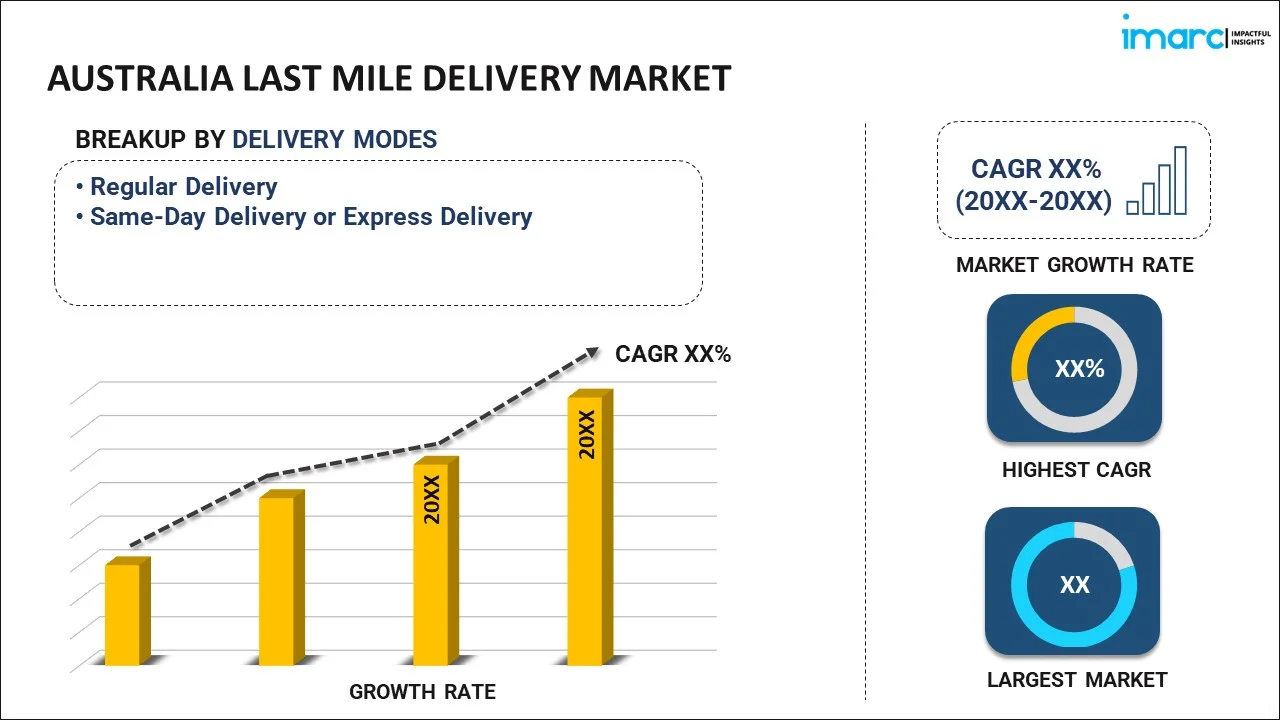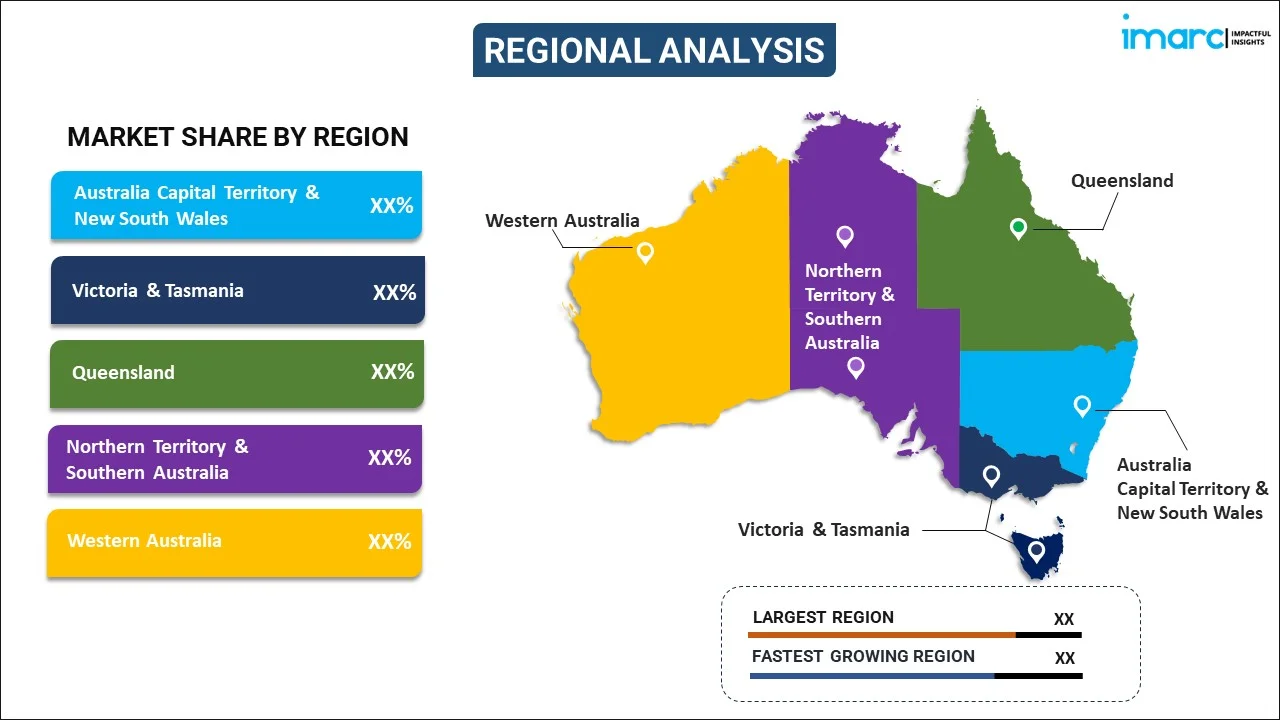
Australia Last Mile Delivery Market Report by Delivery Mode (Regular Delivery, Same-Day Delivery or Express Delivery), Application (E-Commerce, Retail and FMCG, Healthcare, Mails and Packages, and Others), Destination (Domestic, International), Service Type (Business-To-Business (B2B), Business-To-Consumer (B2C), Customer-To-Customer (C2C)), Vehicle Type (Motorcycle, LCV, HCV, Drones), Mode of Operation (Non-Autonomous, Autonomous), and Region 2024-2032
Australia Last Mile Delivery Market Overview:
The Australia last mile delivery market is projected to exhibit a growth rate (CAGR) of 9.50% during 2024-2032. The expansion of e-commerce sector, the increasing consumer demand for fast and convenient delivery services, significant advancements in logistics technology, rapid urbanization, and the rise of innovative delivery solutions like drones and autonomous vehicles are some of the major factors propelling the market growth.
|
Report Attribute
|
Key Statistics
|
|---|---|
|
Base Year
|
2023 |
|
Forecast Years
|
2024-2032
|
|
Historical Years
|
2018-2023
|
| Market Growth Rate (2024-2032) | 9.50% |
Australia Last Mile Delivery Market Trends:
Rising E-commerce Sector
The rapid growth of online shopping facilitates the demand for efficient last mile delivery services to meet consumer expectations for quick and reliable deliveries. According to the International Trade Administration, Australia is the eleventh-largest e-commerce market in the world, and revenue is predicted to reach USD 32.3 billion by 2024. This represents a year-on-year increase of 15.5 percent. In comparison, the bricks and mortar retail market grew by 3.4% over the same period to reach USD200 billion. Online commerce represents approximately nine percent of all retail trade in the Australian market. The largest Australian eCommerce platforms/sites are eBay (AU) (69 million monthly visits), Amazon (AU) (22.5 million), Woolworths (20.4 million), JB Hi-Fi ((13.3 million), Big W (11.9 million), Coles (10.7 million), Kogan (10.2 million), Officeworks (9.45 million), Chemist Warehouse (9.1 million), and Catch (8.95 million). According to Australia Post research, 48.8 percent of all online payments are made via PayPal. Credit and debit cards account for 39.9% of online payments. The fastest-growing segment is the buy now pay later market which accounts for 6.7% of online transactions.
Advancements in Logistics Technology
Innovations in logistics, including real-time tracking, route optimization, and the adoption of drones and autonomous vehicles, enhance delivery efficiency and service quality, propelling market growth. For instance, in June 2024, Hort Innovation inked a three-year strategic partnership with multi-award-winning agency, Thinkerbell, in a bid to drive growth in consumption behaviours for the A$16.3bn horticulture sector. The Australian advertising and creative agency won the contract through a competitive pitch process. The agency will deliver innovative multi-platform grower-funded marketing campaigns for 24 different produce categories including Australian bananas, apples, avocados and more. Hort Innovation chief executive Brett Fifield said the agreement, made in consultation with industry, will deliver maximum value for Australian growers and ensure local produce gets the spotlight like never before.
Australia Last Mile Delivery Market News:
In March 2023, DHL Global Forwarding, the freight specialist arm of Deutsche Post DHL Group, opened its newest facility in Brisbane to meet the surging demand for Australian perishable goods export, with an investment of AU$17 million (11 million EUR) over ten years.
In June 2024, Australia Post introduced major upgrades to its services, including a next-day delivery option - the Australia Post Metro service catering specifically to businesses delivering in the same city, to meet the growing demand for fast and convenient parcel delivery. With customers’ increasing expectations in mind, Australia Post introduced their Metro service last year, and combined with the existing Express Post and StarTrack Premium services, they have both business to business, and consumer deliveries covered.
Australia Last Mile Delivery Market Segmentation:
IMARC Group provides an analysis of the key trends in each segment of the market, along with forecasts at the country level for 2024-2032. Our report has categorized the market based on delivery mode, application, destination, service type, vehicle type, and mode of operation.
Delivery Mode Insights:

- Regular Delivery
- Same-Day Delivery or Express Delivery
The report has provided a detailed breakup and analysis of the market based on the delivery mode. This includes regular delivery and same-day delivery or express delivery.
Application Insights:
- E-Commerce
- Retail and FMCG
- Healthcare
- Mails and Packages
- Others
A detailed breakup and analysis of the market based on the application have also been provided in the report. This includes e-commerce, retail and FMCG, healthcare, mails and packages, and others.
Destination Insights:
- Domestic
- International
The report has provided a detailed breakup and analysis of the market based on the destination. This includes domestic and international.
Service Type Insights:
- Business-To-Business (B2B)
- Business-To-Consumer (B2C)
- Customer-To-Customer (C2C)
A detailed breakup and analysis of the market based on the service type have also been provided in the report. This includes business-to-business (B2B), business-to-consumer (B2C), and customer-to-customer (C2C).
Vehicle Type Insights:
- Motorcycle
- LCV
- HCV
- Drones
The report has provided a detailed breakup and analysis of the market based on the vehicle type. This includes motorcycle, LCV, HCV, and drones.
Mode of Operation Insights:
- Non-Autonomous
- Autonomous
A detailed breakup and analysis of the market based on the mode of operation have also been provided in the report. This includes non-autonomous and autonomous.
Regional Insights:

- Australia Capital Territory & New South Wales
- Victoria & Tasmania
- Queensland
- Northern Territory & Southern Australia
- Western Australia
The report has also provided a comprehensive analysis of all the major regional markets, which include Australia Capital Territory & New South Wales, Victoria & Tasmania, Queensland, Northern Territory & Southern Australia, and Western Australia.
Competitive Landscape:
The market research report has also provided a comprehensive analysis of the competitive landscape. Competitive analysis such as market structure, key player positioning, top winning strategies, competitive dashboard, and company evaluation quadrant has been covered in the report. Also, detailed profiles of all major companies have been provided.
Australia Last Mile Delivery Market Report Coverage:
| Report Features | Details |
|---|---|
| Base Year of the Analysis | 2023 |
| Historical Period | 2018-2023 |
| Forecast Period | 2024-2032 |
| Units | US$ Billion |
| Scope of the Report | Exploration of Historical Trends and Market Outlook, Industry Catalysts and Challenges, Segment-Wise Historical and Future Market Assessment:
|
| Delivery Modes Covered | Regular Delivery, Same-Day Delivery or Express Delivery |
| Applications Covered | E-Commerce, Retail and FMCG, Healthcare, Mails and Packages, Others |
| Destinations Covered | Domestic, International |
| Service Types Covered | Business-To-Business (B2B), Business-To-Consumer (B2C), Customer-To-Customer (C2C) |
| Vehicle Types Covered | Motorcycle, LCV, HCV, Drones |
| Mode of Operations Covered | Non-Autonomous, Autonomous |
| Regions Covered | Australia Capital Territory & New South Wales, Victoria & Tasmania, Queensland, Northern Territory & Southern Australia, Western Australia |
| Customization Scope | 10% Free Customization |
| Post-Sale Analyst Support | 10-12 Weeks |
| Delivery Format | PDF and Excel through Email (We can also provide the editable version of the report in PPT/Word format on special request) |
Key Questions Answered in This Report:
- How has the Australia last mile delivery market performed so far and how will it perform in the coming years?
- What has been the impact of COVID-19 on the Australia last mile delivery market?
- What is the breakup of the Australia last mile delivery market on the basis of delivery mode?
- What is the breakup of the Australia last mile delivery market on the basis of application?
- What is the breakup of the Australia last mile delivery market on the basis of destination?
- What is the breakup of the Australia last mile delivery market on the basis of service type?
- What is the breakup of the Australia last mile delivery market on the basis of vehicle type?
- What is the breakup of the Australia last mile delivery market on the basis of mode of operation?
- What are the various stages in the value chain of the Australia last mile delivery market?
- What are the key driving factors and challenges in the Australia last mile delivery?
- What is the structure of the Australia last mile delivery market and who are the key players?
- What is the degree of competition in the Australia last mile delivery market?
Key Benefits for Stakeholders:
- IMARC’s industry report offers a comprehensive quantitative analysis of various market segments, historical and current market trends, market forecasts, and dynamics of the Australia last mile delivery market from 2018-2032.
- The research report provides the latest information on the market drivers, challenges, and opportunities in the Australia last mile delivery market.
- Porter's five forces analysis assist stakeholders in assessing the impact of new entrants, competitive rivalry, supplier power, buyer power, and the threat of substitution. It helps stakeholders to analyze the level of competition within the Australia last mile delivery industry and its attractiveness.
- Competitive landscape allows stakeholders to understand their competitive environment and provides an insight into the current positions of key players in the market.
Need more help?
- Speak to our experienced analysts for insights on the current market scenarios.
- Include additional segments and countries to customize the report as per your requirement.
- Gain an unparalleled competitive advantage in your domain by understanding how to utilize the report and positively impacting your operations and revenue.
- For further assistance, please connect with our analysts.
 Inquire Before Buying
Inquire Before Buying
 Speak to an Analyst
Speak to an Analyst
 Request Brochure
Request Brochure
 Request Customization
Request Customization




.webp)




.webp)












